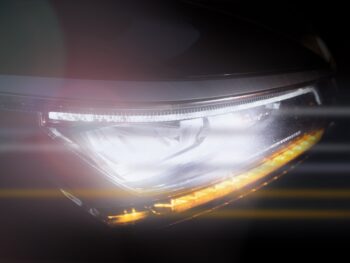RAC calls for government action on headlight glare
The RAC has urged the Government to commission an independent study into the issue of headlight glare as new research indicates risks to road safety.

85% of drivers affected by headlight glare say the problem is getting worse
Its annual survey of headlight glare found nine in 10 (89%) of the 2,000 drivers asked think at least some headlights on cars on the road today are too bright, of which three in 10 (28%) – a higher proportion than ever – think most are.
Among drivers concerned over headlight glare, some 91% say they get dazzled when driving with three-quarters (74%) saying this happens regularly and 85% saying the problem is getting worse.
Of those affected, two in three (67%) say they have to slow down considerably until they can see clearly again, while a similar proportion (64%) believe some headlights are so bright they risk causing accidents. And 5% of these drivers state they have nearly been involved in a collision themselves.
Government collision statistics shows that since 2013, there has been an average of 280 collisions a year where dazzling headlights were a contributory factor. Of these, six a year involved someone losing their life. The actual number may be higher if an investigation was unable to determine whether or not a collision was directly or indirectly caused by the glare from another vehicle’s headlights.
Drivers are also calling for action, with 81% saying more should be done to tackle headlight glare – a figure that rises to 87% among drivers aged 45 to 54.
As a result of the sentiment among drivers, the RAC has raised the issue of headlight glare with the Department for Transport and has been working with a member of the House of Lords, Baroness Hayter, to make drivers’ concerns known among Government officials. The RAC provided details of its research to go into a report published last week and will be meeting with the Government this month to discuss it.
RAC spokesman Rod Dennis said: “We urgently need the Government to take a closer look at the issue, ideally by commissioning an independent study to understand what’s causing an increase in reports of dazzling and, most importantly, what can do be done to keep drivers safe.
“With spring still a long way off, there’s a good chance many people will do most of their driving in darkness over the next few months and, according to our research, that means an awful lot of drivers will experience the discomfort and even danger that comes from being dazzled by headlights.”
Baroness Hayter added: “Government should take action now to be on the side of road safety and ensure everyone keeps to the Highway Code, which states drivers ‘must not use any lights in a way which would dazzle other road users’.”
The RAC research also reveals that almost one in 10 (7%) drivers say they find headlight glare so bad that they avoid driving at night altogether, a figure that rises to 14% for those aged 65 and over.
The study also explored drivers’ estimates on how long it takes them to see clearly again after getting dazzled by other drivers’ lights. While 68% say it takes between one and five seconds, one in 10 (11%) say it takes six or more – which, staggeringly, is enough for a driver travelling at 60mph to cover 160 metres, the equivalent of 40 car lengths.
As to the reasons why headlight glare is getting worse, 87% of dazzled drivers think it is mainly due to the fact some lights just appear much brighter. This could be due to the increasing use of LED headlights on cars, leading to a much more intense and focused beam that the human eye reacts differently to, compared to a conventional ‘yellower’ halogen bulb.
But more than four in 10 (44%) think the dazzling is caused by badly aligned headlights. A Freedom of Information request submitted to the Driver and Vehicle Standards Agency (DVSA) in November 2023 shows that since 2019, an average of 1.6 million, or 5%, of Class 4 vehicles – which includes passenger cars – failed their MOTs as a result of poor headlight aim.
The increasing popularity of cars riding higher on the road, especially SUVs, could also be a factor, especially as those in more traditional cars such as hatchbacks, saloons or estates seem to suffer the most. Six in 10 drivers (62%) of such cars blame the dazzle on higher-riding vehicles, as opposed to 35% of those in such vehicles.
IAM RoadSmart director of policy and standards Nicholas Lyes said: “Drivers are increasingly telling us they are concerned by modern headlights and some are now even limiting the amount of time they spend driving during darkness to avoid glare. Being dazzled by a headlight has a worrying impact on road safety and we need policymakers to take this matter seriously.”












